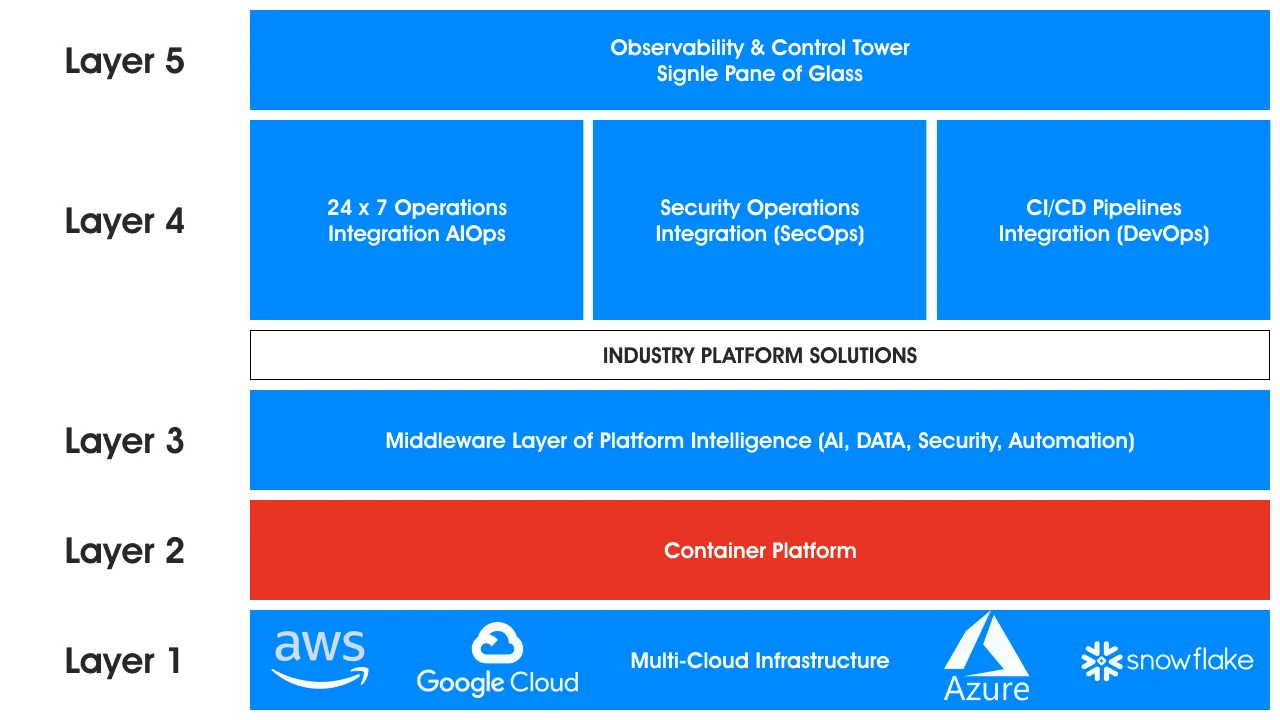Multi-Cloud vs Hybrid Cloud: A Deep Dive into Key Differences, Strategies, and Architectures
Table of Contents
In 2023, Flexera predicted that over 72% of all enterprises are already using a hybrid cloud model, which highlights the significance of hybrid cloud strategies as big companies move away from traditional IT infrastructure.
This growing interest of businesses in cloud computing requires a well-defined cloud strategy that aligns with your business needs. Well, two cloud strategies are growing in popularity: Multi-Cloud and Hybrid Cloud.
And considering Gartner’s prediction that 85% of businesses will adopt a hybrid cloud strategy, it’s important to identify which of these two is an ideal choice.
This blog is your one-stop guide discussing everything about Multi-cloud vs hybrid cloud and what differentiates them with each other. Not only this, you will explore best practices for implementing multi cloud and hybrid cloud.
However, you must be aware that mere cloud migration isn’t enough. Understanding the “why” and strategizing it correctly is what will lead to cloud success.
So, stay connected and find out which is the best solution for your business. This is multi-cloud vs hybrid cloud.
What is Multi-Cloud?

In Multi-Cloud, a business uses multiple public clouds from different cloud service providers, such as AWS, Google Cloud Platform, Microsoft Azure, and more. Sometimes, businesses deploy SaaS or PaaS for many business operations while keeping the hosting workload and infrastructural management to IaaS in the public cloud.
Another example can be: suppose you are a big IT service provider using a multi-cloud strategy and deploying Microsoft Azure for databases, AWS for app development and testing, and Google Cloud for website and further platform scaling. This brings benefits like optimized budget utilization, no vendor lock-in, and getting all the best functionalities from each provider.
Now, let’s know what multi-cloud is made up of:
Multi-Cloud Architecture
Multi-cloud architecture is the setup of infrastructure capable of hosting and utilizing multiple cloud computing services from different cloud providers. This architecture provides impressive flexibility and choice of cloud solutions. You can also decide on the best service based on factors like performance, security, cost, and others.
Here is what Multi-cloud architecture is made up of, i.e., its key components:
1. Load Balancing Server (SLB): It distributes web traffic across multiple servers of the different cloud services you are using. SLB (Server Load Balancing) ensures your application is performing smoothly and is scalable when you decide to expand or condense, giving you space to handle traffic spikes efficiently.
2. Application Server: This is basically a trusted cloud environment that allows you to run on-demand web applications. It also includes the memory needed for real-time operation and processing power. In multi-cloud architecture, you can choose the best resources from different providers to meet your specific needs.
3. Redundancy and Backup Server: It’s like having a duplicate server across multiple cloud providers, ensuring you don’t have to compromise when you need their services the most. It also protects your applications from experiencing downtimes in times of server failures.
4. Database Server: It’s a dedicated environment for running database management software and handling large-scale data processing. Multi-cloud allows client-server architecture to facilitate real-time data processing and efficient data retrieval.
5. Horizontal Auto Scaling: This automatically scales cloud resources up or down as required, eliminating the stress of processing power or storage space running out, irrespective of the fact how much your provider can offer.
Challenges with Multi-Cloud Strategy
Although it is highly beneficial, a multi-cloud strategy can also have some challenges, such as:
- While most cloud providers offer secure environments, data breaches can occur during cloud migration across multiple networks. Managing security configurations in a multi-cloud environment can also be complex. However, you don’t need to be a security expert. Cloud computing consulting services can help you get through these challenges and ensure your team is working in a secure multi-cloud environment.
- Improper data storage and management can impact the strict adherence to compliance.
You can navigate through all these challenges when you have the right multi-cloud strategy in hand.
Why you should get a Multi-Cloud Strategy?

Several reasons are getting businesses to embrace the power of multi-cloud strategies. Following are some benefits that you can expect:
1. Cloud Modernization: Once you get multi-cloud, you also sign up for a wide variety of tools and services like microservices, APIs, servers, storages, etc., which allows you to build modern applications and stay ahead of the competition.
2. Staying agile and scalable: By utilizing multiple cloud services, you can easily avoid vendor lock-in and close the cloud service contract on your budget. Plus, you also get access to several functionalities offered by each provider. Another good thing is you can scale up or down instantly at any time per your changing requirements.
3. Sharing Best Practices: Every cloud has different best practices, and once you work with each one, you gain a lot of knowledge that can be applied to other clouds (private or public). These practices focus on improving overall performance and resource utilization.
4. Adhering to the Necessary Compliance: Data residency regulations like GDPR in Europe can vary by region. A multi-cloud strategy allows you to choose providers that keep every compliance in mind and store your data accordingly wherever it needs to be to comply with local laws.
What is a Hybrid Cloud?

A Hybrid Cloud Computing Architecture is formed by combining two or more different clouds, one of which must be a private cloud solution and one of which must be a public cloud solution.
Many organizations (53%, according to Cisco) are embracing hybrid cloud due to its flexibility. It allows businesses to migrate workloads strategically, keeping sensitive data or resource-intensive applications secure on-premises. Dynamic workloads are migrated to the public cloud, offering cost-effectiveness and scalability.
A hybrid cloud strategy combines cloud resources with on-premises infrastructure, allowing companies to orchestrate and manage workloads in different cloud environments. Overall, a hybrid cloud approach offers businesses a dynamic and adaptable IT solution.
Hybrid Cloud Architecture

Here is what keeps Hybrid cloud working:
1. Infrastructure Layer
The infrastructure layer is also known as the foundation of hybrid cloud architecture, which includes on-premises networks and cloud extensions. It demands consistent consideration of policies such as gateways, firewall rules, IP management, and latency.
It is recommended to adhere to best practices, manage traffic cost of data across regions, and create logging services on the basis of application needs and complexity; if you are adopting a cloud-first approach.
2. Container Platform Layer
The objective of this layer is to ensure that both workload deployment and management across cloud and on-premises are consistent. This involves overcoming operational disruptions between teams and training them on various skills like DevOps, Infrastructure as Code (IaC), Site Reliability Engineering (SRE), and a container platform that can handle workload portability. You can make choices among a hyperscaler’s tool or an adaptable and open container strategy.
3. Middleware Layer
This layer is responsible for data, AI, automation, and security. AI, capacity orchestration, and autoscaling demand properly logged data, and it is crucial for a business to integrate security measures in development and get secured database technology to maintain confidentiality.
Organizations must decide between asynchronous and synchronous writes for data consistency, impacting resiliency and cost.
4. Operations Layer
The operations layer comprises AIOps, SecOps, and DevOps, supported by logging data for incident and change management. According to experts, it’s best to implement observability and performance tools to improve cloud service cost visibility. To efficiently manage your cloud resources across different environments (development, testing, production, etc.), close collaboration between your platform engineering and DevOps teams is essential.
In addition, a clear and functional service catalog can become a central hub for deployment instructions and best practices for your team. It promises consistency and reduces errors while your team deploys applications across your hybrid cloud, making everything run smoothly and predictably.
5. Observability Layer
The observability layer provides a unified view of applications across hybrid cloud platforms with consistent security and compliance. It helps operations teams identify issues early, supports efficient patching and upgrades, and offers a comprehensive view of IT health. It also facilitates event correlation, data aggregation, and AI-driven monitoring, simplifying cloud management.
Challenges With Hybrid Cloud Strategy
Apart from everything good, the Hybrid cloud has its shortcomings:
- Seamless connectivity is complex to establish when you connect different cloud platforms with your existing legacy systems.
- The complexity of the cloud setup will define how hard a time your team will have to manage it.
- Hybrid cloud systems run on wide-area networks, which have the maximum risk of latency issues because they need to transfer small, uncompressed data packets instead of a remote connection.
There could be more to this list, but you can always get help from cloud consulting services and implement a hybrid cloud model and ensure your team knows every trick of it.
Why should you get a Hybrid Cloud Strategy?

Here’s what researchers found why a business must get a hybrid cloud strategy:
- Data Security
The public cloud has received considerable attention for its various functionalities, such as backup, recovery, enterprise data protection, and more.
Organizations can use existing on-premises data protection tools or rely on managed service providers for backup, snapshots, and disaster recovery, who can also handle compliance and regulations like HIPAA, PCI, and GDPR. Migrating from tape to cloud backup reduces data restoration time and improves RPO/RTO from days or hours to seconds.
- Innovation
With a hybrid cloud strategy, both development and R&D teams can experiment without costing the company anything extra. Public cloud providers offer cloud modernization, application development, and infrastructure modeling. Once new applications are developed and approved, your team can rapidly deploy them in the public cloud, even if the goal is to migrate them on-premises eventually.
- Business Agility
The IT industry is now more inclined to “do more with less.” A Hybrid Cloud strategy can help with this by improving agility, enabling prototyping application development, and enhancing mobile app user experiences.
- Scalability
The hybrid cloud fulfils the ongoing demands of everyone, from holiday shoppers to media exposure to new product launches. It eliminates the requirement for buying resource projections just by employing public cloud resources that can be scaled up and down as needed, making it an ideal choice.
- Time-to-Market
Traditional cloud procurement cycles can take weeks and months, which can keep new business initiatives. Hybrid Cloud allows Line of Business (LOB) and IT teams to deploy new infrastructure quickly and fulfill development, testing, or deployment needs, which increases time-to-market.
Multi vs Hybrid Cloud – Key Differences

| Basis | Multi-Cloud | Hybrid Cloud |
| Architecture | Comprises of Public and private clouds or on-premises data centers (or both) | Combination of Public Clouds (Can also include Private or Community cloud and on-premises databases) |
| Flexibility and Scalability | Greater flexibility by using services from different cloud providers. | Allows you to scale up and down easily with cloud services, while offering the control and security of your infrastructure. |
| Cross-cloud workloads | Components of different platform work together to make a single IT solution work smoothly, which intersects data and processes. | Different clouds perform different tasks, so data and processes often run in silos. |
| Vendor lock-in | Multiple integration between cloud environments makes switching to suppliers difficult. | Multiple cloud providers and independent workloads provide the flexibility to switch vendors easily and quickly |
| Data Residency | Data lives on both on-premises servers and private cloud | Data resides either on-premises or in the cloud, depends how you have designed it. |
| Data Security | Internal teams are responsible for protecting data in private clouds and data centers; provider handles public cloud security | Public cloud providers are responsible for cloud computing security |
| Cost | Minimal scope of overrunning, but high staffing and maintenance costs. | Public clouds are cheaper than private clouds or data centers, but careful spending is recommended. |
| Cloud Migration | Migration process is less difficult and comparatively short as the major workload is on local servers. | Migrating to multiple clouds is somehow challenges and time-consuming |
| Availability | Users may experience problems if public cloud encounters problems preventing cloud bursting | If one provider goes down, workloads can be moved to another; organisations can also set up separate public clouds based on user location to avoid delays |
Selecting the right cloud model (multi or hybrid cloud) calls for thoughtful considerations. It’s important to assess your business needs before you go out and look for a cloud provider. Companies who can’t compromise on security must prioritize getting a private cloud and those with easy maintenance as requirements can go for a single public cloud provider.
Where hybrid cloud offers flexibility but can exceed your costs, multi-cloud allows you to select from the most cost-effective solution but have its own limitations (can limit where you can run your applications.
Finally, companies should consider future growth alongwith cloud sustainability and select a cloud strategy that scales easily without breaking the bank. Technical expertise is essential too. Whilst you can’t have it all in your company, that’s where you can connect with a cloud consultant to make sure that you are taking the right decision and not spending blindly.
Can Hybrid Cloud work as Multi-Cloud?
It’s the question that many are asking.
The terms “hybrid cloud” and “multi-cloud” isn’t that tricky but sometimes they can overlap. So, here’s the simplest difference for you:
- Hybrid cloud: A combination of a private cloud (with your very own infrastructure) and a public cloud (from a cloud services provider).
- Multi-cloud: Uses multiple public cloud services from different cloud providers.
Now, things get interesting. A Hybrid cloud can be multi-cloud if it includes more than one public cloud service with a private infrastructure, allowing you get capabilities of various platforms while keeping control of on-premises data.
Let’s make it more clear with an example. Consider hybrid cloud is the foundation, and you can design a multi-cloud strategy on top of it by adopting different public cloud (like AWS, Azure, or GCP). This gives you the best of both worlds: secure integration with your infrastructure and the flexibility to choose the most cost-effective options from different cloud providers.
So, we can conclude that while hybrid cloud is focused on public-private integration, it can also be converted into a multi-cloud environment.
Use Cases For Multi and Hybrid Cloud
Multi Cloud Strategy in Action: Walmart
Retail giant Walmart also utilizes a multi-cloud strategy to deal with its massive scaling, peak season spikes, and diversifed needs. By strategically using a combination of cloud providers like AWS, Azure, and potentially GCP, Walmart allocates workloads based on their strengths. AWS handles core operations with its robust security, Azure helps manage peak season traffic with auto-scaling, and GCP (potentially) enables faster global expansion with geographically distributed data centers. This multi-cloud approach allows Walmart to adjust scalability, reduction in costs, access to best cloud services, improved global reach, and increased agility.
Hybrid Cloud Strategy in Action: Mayo Clininc
When it comes to Hybrid Cloud strategy, one of the names in list is Mayo Clinic who are utilizing a hybrid cloud strategy to keep the patient data secure. They are storing patient’s sensitive data on-premises for high-end security and adhering to HIPAA compliance. And externally using Google Cloud Platform for many operational tasks like medical research, AI development and collaborative innovation platforms. This approach empowers them with scalability, faster research, and improved collaboration, all while prioritizing patient data privacy and focusing on their core medical expertise.
Cloud Strategies on the Rise: Hybrid and Multi-Cloud Future Trends
As per Gartner’s prediction, nearly half of mid-to-large businesses are going to adopt hybrid cloud infrastructure by 2028.
Well, this is just one prediction and that too about Hybrid Cloud, multi-cloud is also gaining the same traction and here is how both of them are benefitting businesses and creating new trends for businesses:
Hybrid and Multi-Cloud: Shaping the Future
Both hybrid and multi-cloud strategies empower businesses to customize their cloud infrastructure as per their unique needs. As a result, the future of cloud computing is likely to get build on a hybrid environment where public and private clouds with multiple cloud providers will co-exist and deliver optimal flexibility and control to businesses across industries such as:
- Finance: Hybrid cloud enables secure storage of sensitive customer data on-premises while deploying public cloud for customer-facing applications.
- Healthcare: Patient records can be securely stored in a private cloud or on-premises while non-sensitive tasks like administrative jobs can run on public cloud handling everything from compliance to cost-efficiency.
- Manufacturing: For Manufacturers, Hybrid cloud monitors production processes using public cloud IoT integration, while securing valuable intellectual property within private cloud environments.
What you can expect from Multi-Cloud?
- Serverless On The Rise: In Multi-cloud, serverless computing is also going to be there for making outsourcing of infrastructure management easy, so your team can focus solely on your application code. It’s pay-per-use and automatic scaling are key benefits.
- Matching Needs & Services: Multi-cloud allows businesses to choose the best provider for each application, optimal app performance, scalability, and reliability.

The Final Take
In conclusion, the decision between adopting a multi-cloud or hybrid cloud strategy depends entirely on the unique needs and goals of your organization. Don’t overlook key considerations such as cost, security, control, flexibility, and integration before you take the final call, so that your cloud infrastructure is optimized enough to meet your business goals.
For organizations looking for establishing an engineering team and incur additional cost, you can consider partnering with a company cloud consulting company. At Cyntexa, we focuses cloud development along with application workloads, cost management, and risk reduction.
Ready to redefine the power of the cloud with a customized strategy and expert support? Contact Cyntexa today and let’s discuss your cloud journey!
Don’t Worry, We Got You Covered!
Get The Expert curated eGuide straight to your inbox and get going with the Salesforce Excellence.








